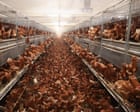The recent ecologicalcollapse of the River Wyedue to pollution from intensive agriculture has been well documented. But the slow-motion repetition of this ecocide on the neighbouring River Severn has largely unfolded out of sight.
For years, local authorities have been waving through industrial-scale livestock production units across the catchment of this iconic river. These toxic megafarms produce vast quantities of animal waste, which is spread on local land with minimal consideration for the cumulative environmental destruction it can cause.
This week, the high court called time on this practice. In a landmark ruling, the court quashed Shropshire council’s planning permission for a230,000-bird intensive poultry unitnear two protected wetland sites and a mile from the banks of the Severn. The court found the council had unlawfully failed to assess the cumulative impact of adding yet another waste-spewing chicken megafarm to an already bloated cluster ofintensive poultry units(IPUs).
Digestate, the byproduct of these plants, is often spread excessively on farmland. It can be highly toxic and rich in nitrates and phosphates, the very substance fuelling ecological collapse in rivers such as the Wye and Severn. The court found this risk was not incidental but a foreseeable impact that should have been evaluated under the law.
This judgment sets a critical precedent. Local planning authorities can no longer ignore the full environmental footprint of these developments. They cannot assume waste vanishes once it leaves the farm gate. Most significantly, they cannot continue treating each factory farm unit as isolated when together they create a systemic environmental crisis.
In Shropshire, more than 28m chickens are crammed into anescalating number of industrial sheds. The proposed site was just 400 metres from another unit housing nearly half a million birds. Satellite images show many others blanketing the surrounding landscape.
This slow death by poultry units has been made possible by a negligent planning system. It also exposes a gaping hole in how environmental waste is regulated. Digestate is not benign. The dense concentrations of nitrates and phosphates it carries fuel catastrophic algal blooms. Yet councils have routinely treated it as someone else’s problem. The court was clear: those days are over.
It also struck down Shropshire’s vague, unenforceable planning conditions, which tried to shift responsibility for manure disposal to third parties without oversight or accountability. This legal sleight of hand no longer holds. Local authorities now must know, and can enforce, exactly what happens to the waste. “Somewhere else” is no longer a defence.
The ruling lands at a crucial political moment. The Labour government has made clear its intent toloosen planning restrictionsin the name of growth. But environmental protections are not bureaucratic burdens. They are the last line of defence against irreversible harm. This case reaffirms that environmental law has teeth and must be upheld even as politics shifts towards deregulation.
So what happens now? Shropshire council has confirmed it will not appeal. The developer may resubmit a new application, but any future proposal must address the court’s findings: a lawful environmental impact assessment and a rigorous, science-based assessment of cumulative harm under the habitats regulations.
More broadly, this judgment should send shockwaves through the planning system. Councils will have to stop rubber-stamping similar poultry applications and should review their processes. Developers will face greater scrutiny. And communities fighting to defend their rivers now have powerful new legal tools at their disposal.
Of course, there will be resistance. The big agri lobby will whine about red tape. But what it calls red tape is simply the law – which is put in place to protect public and environmental health, not industrial convenience. If you want to dump another 200,000 chickens into a river catchment already choking on phosphates, the burden is now on you to prove you won’t make things any worse.
Having instigated and funded this landmark legal action, River Action will now go into overdrive to ensure this case law is embedded across the UK’s planning system. We’ll also support other courageous local campaigners – like our advisory board member Dr Alison Caffyn, who personallyled the Shropshire claim. Backed by our legal team, we’re fully armed for the fight againstindustrial factory farming.
Had this ruling come a decade earlier, the River Wye’s collapse might have been prevented. Now there’s real hope for other iconic rivers.
Charles Watson is chair and founder of River Action
